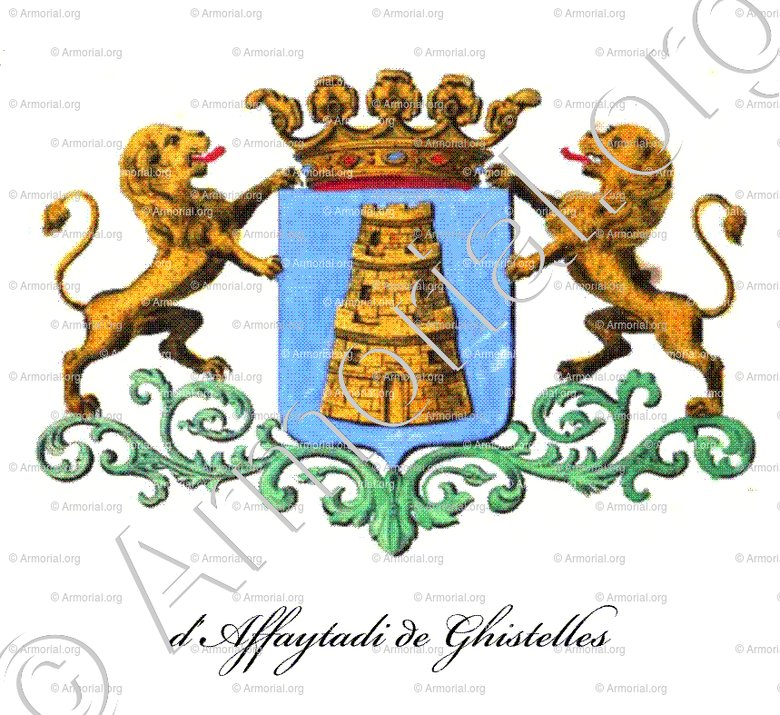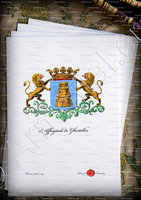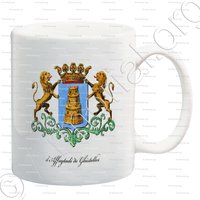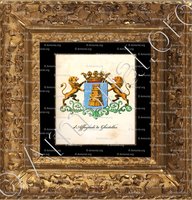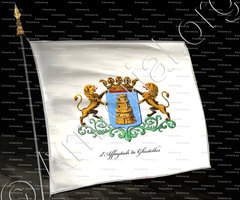DESCRIPTION
d'AFFAYTADI de GHISTELLES
Bruges, Hainaut.
Belgique
Prince de Hilst, 23 mai 1563; comte de Ghistelles, 21 janvier 1676.
Armoiries :
" D'azur, à la tour de trois étages d'or, portillée de sable. "
- Cimier: un pélican avec ses petits dans son aire, d'or.
- Supports: deux lions d'or, lampassés de gueules.
- Devise: JE VIVE EN ESPOIR.
AFFAYTADI DE GHISTELLES
AFFAYTADI's family is originally from Cremona.
Whatever his illustriousness in Italy, we can recognize no other leader than Jean-Charles D'AFFAYTADI.
Nevertheless, an act signed by the jurors and sworn archivists of this city on October 28, 1562, provides some information:
"This illustrious family produced a certain François AFFAYTADI, who, "as fame tells us, was so dear to the King of Portugal and so "intimately linked with him that this prince consulted him on all his affairs" and his negotiations, and that he never undertook anything without the opinion and advice of this lord.
Death having prevented him, he left two sons alive and residing in Portugal.
This François had brothers: a certain a P.-Martin and a certain C.-Louis, both attached to the illustrious dukes a and princes of the states of Milan; the son of C.-Louis was a certain "Baptiste who had three sons and who also had a certain Lazare, our colleague, a man of great prudence and great moral integrity, allied with the one who must be named here below, and again John has Charles and John the Baptist, brothers of Lazarus.
It will perhaps be superfluous to say something of their name and fame, since they are known among all civilized peoples and have lived in Brabant.
years when John - harles died, who during his lifetime gave so much money to Charles V, invincible emperor, and to the most serene and catholic king of Spain when they had war against the king very Christian and the princes of Germany, that one can almost say "with reason that they supported this war by the money of Jean-Charles" who left children leading in the parts of Brabant a very " honest and very honourable".
Much more could be said of “this man; but because the memory of his actions is still recent, "it seems to us that we can pass over several of his memorable facts in silence." This is therefore used for our attestation, having it provided (with our seal.)
The first to settle in Belgium was Jean-Charles D'AFFAYTADI mentioned above; he settled in Antwerp in 1498 and traded with remarkable success.
In 1545, he bought from the emperor the land and seigneury of Ghistelles which had been confiscated from Antoine de Luxembourg and his wife Marguerite de Savoye, for felony.
According to Sanderus, a friend of the AFFAYTADI family, the word barony was found in the act Jean-Charles D'AFFAYTADI still acquired the lordship of Zelzaete.
About this seigniory, the Prospectus castellorum et prætoriorum procerum et nobilium Brabantiæ ex museo Jacobi baronis Le Roy, plate 129, reports the following: “Zelzaete is a castle in the village of Wommelghem, in the town hall of Santhove.
It was formerly a freehold of the house of Berchem.
Jean Van Berchem, son of Jean-le Grand, or, as the letters patent bear textually, groot Jans sone wiens vader "Willem was, lived in this house until the year 1535 as "Jean-Charles D'AFFAYTADI , gentleman of Cremona, bought it and made it “more magnificent, by having it rebuilt from the foundations; he left it to his descendants, barons of Ghistelles.
But by the misfortunes of the civil wars of the Netherlands, in the last century, this beautiful castle was burned, whence it was called the Verbrand Hof; and Zelzaete's name was forgotten.
The "old records certify that he once had the right of asylum, hunting and "other notable privileges. »
The diploma given by the Emperor Ferdinand to the son of Jean-Charles, in 1563, contains part of his biography, in these terms: "When under the government of our sister Queen of Hungary, the enemy army marched in great force and with great strides towards the city of Antwerp and that, in this "conjuncture, the merchants and traders frightened by this march had resolved to abandon the city and move elsewhere, because this city was not provided with of a garrison strong enough or sufficient to resist the enemies, then the said count, knowing the danger, assembled with the greatest promptitude and acceleration a great number of people....
Jean-Charles D'AFFAYTADI died on December 24, 1553 and was buried in the choir of the church of Ghistelles; his tomb is surmounted by his effigy in coat of arms and decorated with escutcheons without coat of arms.
He had married Lucrèce d'AFFAYTADI, his cousin, daughter of Jean-François; who died on March 19, 1569 and was buried in the church of Sion, in Lierre.
Immediately after the establishment of Jean - harles D'AFFAYTADI in Antwerp, his parents came to join him; in a short time his family spread throughout Brabant, and mainly to Lier, Mechelen and Louvain.
In the church of Saint-Quentin of this city, there was in 1759 a blue stone which bore the following inscription: "... AFFAITORUM familià nobilissima...".
Jean-Charles D'AFFAYTADI had at least six children; the eldest, Jean-François, built the hospital of Ghistelles.
In consideration of the services rendered by his father to the House of Austria, he was created Prince of Hilst by the letters patent of which we have given an extract above.
The Prince of Hilst died in Italy in 1595, leaving no posterity.
If it is true, as Sanderus asserts, that the sovereign sold a barony to Jean-Charles D'AFFAYTADI, it did not follow that he had the right to bear the title. , Caesar, who died in the year 1636, called himself a baron.
It was a first step towards a new enlargement, of which the family proved itself worthy.
On January 21, 1676, the land of Ghistelles was erected into a county in favor of Jean-François D'AFFAYTADI, son of Jean-Charles, who died in 1635, and Barbe de la Haye.
He was therefore the first Count of Ghistelles.
He died on February 8, 1681; his wife, whom he had married in Bruges on November 3, 1635, was Laure-Thérèse d'AFFAYTADI, his first cousin, daughter of César, baron de Ghistelles, and Madelaine de Camargo.
In addition to the alliances indicated above, this family contracted others no less honourable, for example with Jean de Montmorency, lord of Bours; with Othon d'Arckel, lord of Heukelom, son of George, lord of Heukelom and Anne of Lockhorst; with Rasse-Léonard Van der Noot, baron of Kieseghem; with Anne-Philippine de Thiennes, daughter of René, Count of Rumbeke, and Jeanne-Fançoise-Marie de Croy-Rauls; with Isabelle-Claire-Philippine d'Haveskercke, daughter of Charles, Baron de Winghene, and Anne-Isabelle Verreycken; with Marie-Jeanne-Anne de la Coste, daughter of Jean and Elisabeth Leeu.
King Guillaume authorized Auguste-Augustin-Joseph-Ghislain D'AFFAYTADI to add to his name that of the land of Ghistelles that his family had owned for so long and granted him and his descendants the right to bear the title of count.
The family is not extinct; but, in default of males, the name is lost.
Sources:
- Genealogical and Heraldic Dictionary of the Noble Families of the Kingdom of Belgium, by M. Félix-Victot Goethals, 1843.
PARTAGEZ SUR LES RÉSEAUX SOCIAUX
LES AVIS
Il n'y a aucune note pour le moment. Soyez le premier à évaluer !
DONNEZ UNE NOTE




